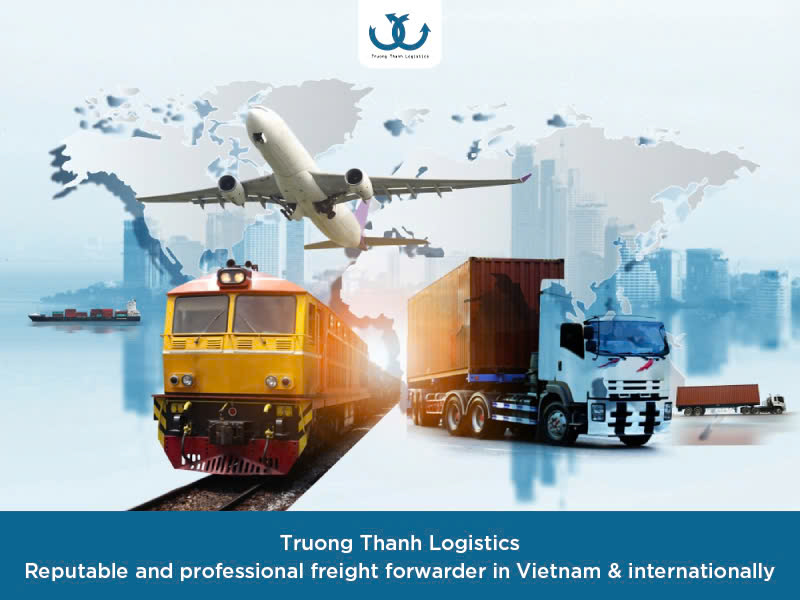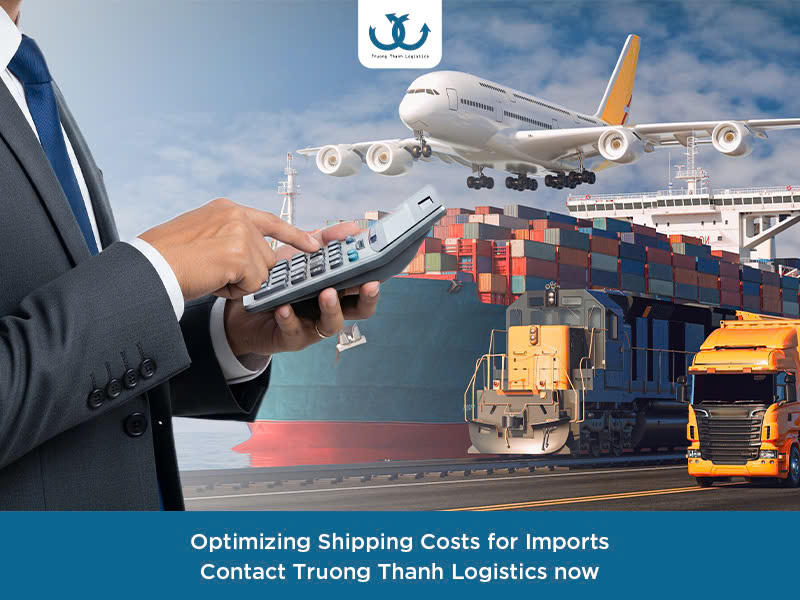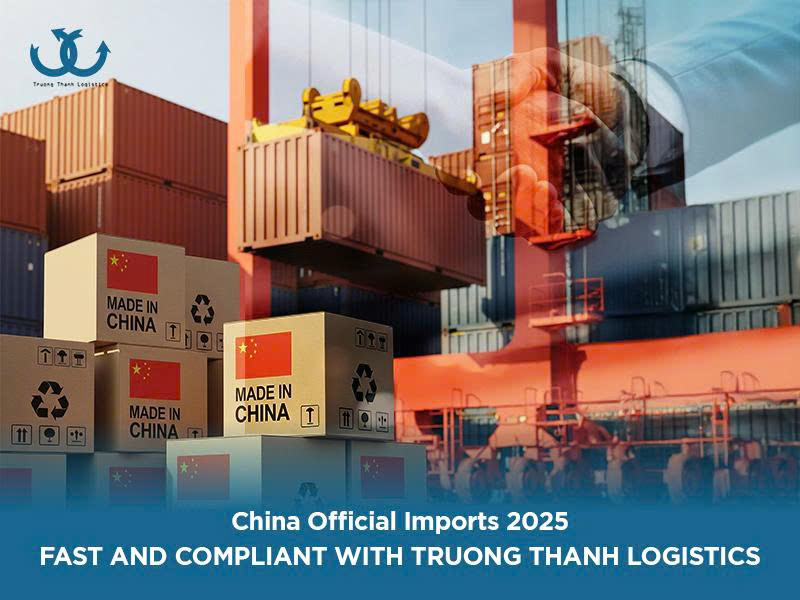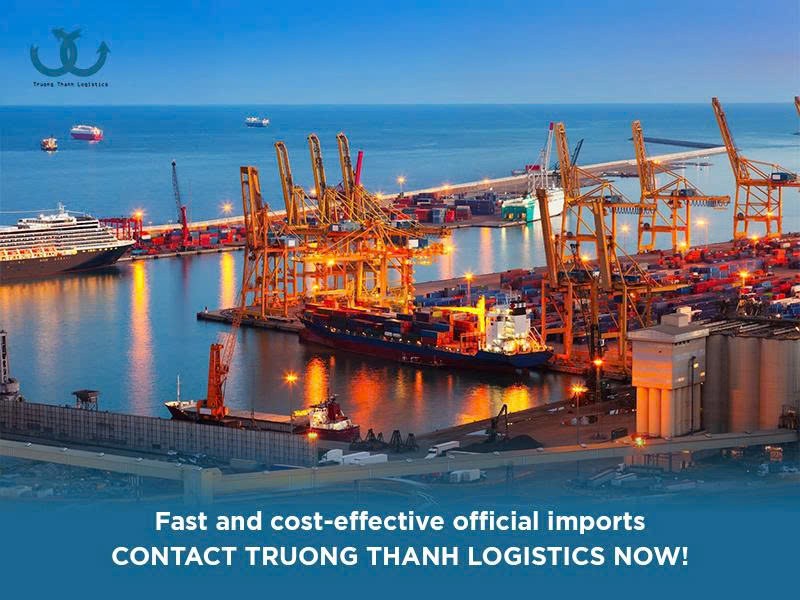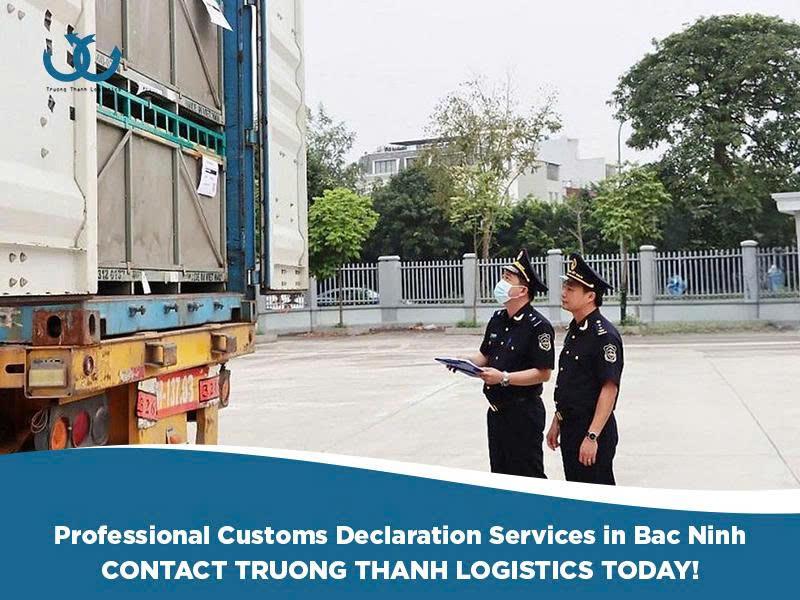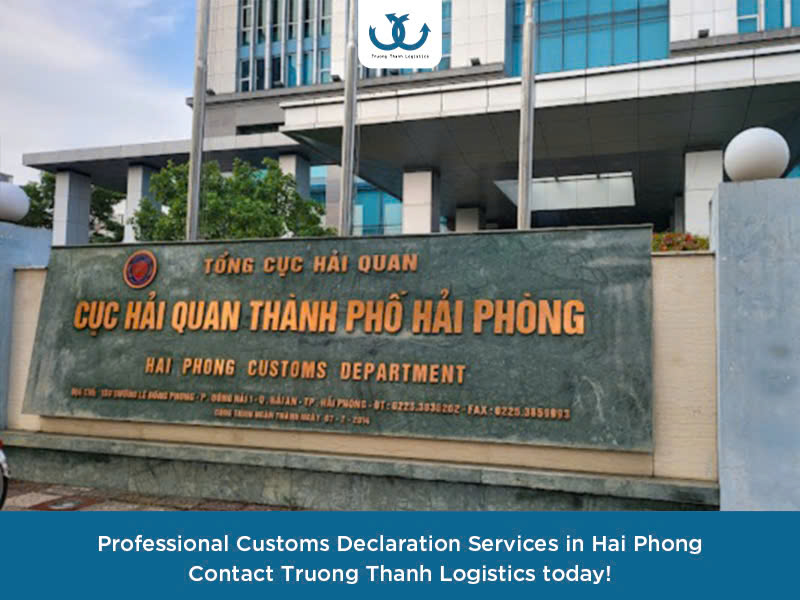Importing is playing an increasingly important role in the global supply chains of Vietnamese businesses. From raw materials for manufacturing and machinery parts to high-end consumer goods, foreign products not only supplement domestic demand but also enhance product quality and competitiveness.
However, many new or inexperienced businesses face significant challenges: goods being held at ports due to incorrect documents, daily storage costs, or heavy fines for violating customs regulations. The root cause often stems from choosing an unsuitable import method, especially when underestimating the importance of official imports.
Official imports are not just the “legal” way to trade under international and Vietnamese law—it’s also the path to ensuring stability, security, and credibility in business. With over 13 years of experience, Truong Thanh Logistics has partnered with thousands of businesses on their official import journeys, helping them optimize costs, save time, and minimize risks.
1. What Are Official Imports?
Official imports (Nhập khẩu chính ngạch) is the process of bringing goods into Vietnam from abroad through international or state-sanctioned border gates, with a complete foreign trade contract, valid documents, customs declarations, and full payment of taxes as required by Vietnamese law.
More than just a transportation process, official imports are a transparent and legally compliant trade activity that protects the rights of both buyers and sellers.

1.1. Transactions Based on a Legal Foreign Trade Contract
+ A Sales Contract is signed between the buyer and seller, clearly stating terms such as: product name, quantity, unit price, delivery terms (Incoterms), payment conditions, and responsibilities of each party.
+ This contract is the legal basis for resolving disputes if risks arise during the transaction.
1.2. Complete and Valid Documentation A set of official import documents typically includes:
+ Commercial Invoice: Proves the value of the goods and transaction details.
+ Packing List: Details the packaging, weight, and number of packages.
+ Bill of Lading: The transport document that confirms ownership of the goods.
+ Certificate of Origin (C/O): Proves the goods’ origin, allowing for preferential tariffs (if applicable).
+ Specialized licenses: For goods under special management (e.g., food, pharmaceuticals, specific machinery).
1.3. Legal Payment Methods
+ T/T (Telegraphic Transfer): Direct electronic transfer from the buyer’s bank to the seller’s bank.
+ L/C (Letter of Credit): A letter issued by a bank that guarantees payment when the seller meets the delivery conditions.
+ These methods minimize financial risks and increase trust in international transactions.
1.4. Customs Inspection and Clearance
+ Goods are inspected by the General Department of Vietnam Customs, either through documents and/or physical inspection, to confirm their validity.
+ Only after completing tax obligations and customs procedures can the goods be legally circulated in the Vietnamese market.
Thanks to their transparency, compliance, and legal integrity, official imports are the optimal method for businesses that want to build a long-term reputation, expand their market, and avoid legal risks.
2. Official vs. Unofficial Imports: Which is the Safer Choice for Your Business?
Many small or new businesses opt for unofficial imports (tiểu ngạch) because they believe it’s a fast solution with fewer procedures and lower initial costs. However, unofficial imports carry many hidden risks: goods are not legally protected, they can be easily confiscated, and it’s difficult to get them into official distribution channels.
|
Criteria |
Official Imports |
Unofficial Imports |
|
Legal Basis |
Protected by law |
No legal protection |
|
Documentation |
Complete and transparent |
Incomplete or non-compliant |
|
Payment |
Legal, via bank |
Cash or personal accounts |
|
Taxes & Fees |
Paid in full |
May evade taxes but risks severe penalties |
|
Scalability |
High, suitable for long-term business |
Limited, only suitable for small transactions |
Choosing official imports means building a sustainable foundation, ready to scale and partner with large companies, rather than focusing solely on short-term gains.
3. Benefits of Official Imports
In the context of global economic integration, the choice of import method doesn’t just affect costs—it also determines a business’s credibility and potential for sustainable growth. Official imports bring significant strategic value, helping businesses improve their position and expand their market.
+ Absolute Legal Security: With official imports, all transactions comply with legal regulations, from the international sales contract to customs procedures. This protects a business’s rights in case of disputes, avoiding the risk of goods confiscation, administrative fines, or business disruption. This transparency is especially crucial when working with large partners or participating in bids.
+ Wider Market Access: Officially imported goods have valid documents, clear origins, and quality standards, making them easy to distribute through official retail channels like supermarkets, shopping malls, and specialized store chains. This opens up opportunities to reach customers on a large scale, increasing sales and market share.
+ Long-Term Cost Optimization: While initial costs may be higher than unofficial imports, official imports help avoid unexpected expenses like storage fees from held goods, administrative fines, or re-processing fees. In the long run, this is a more cost-effective and efficient solution, especially for businesses that want to maintain a stable and sustainable supply.
+ Increased Credibility and Sustainable Brand Building: A business that is transparent about its goods’ origin and quality builds strong trust with customers and partners. This is a key factor in expanding cooperation, getting priority in major deals, and building a professional, reliable brand image.

4. Common Official Import Methods
When engaging in import activities, choosing the right method is crucial, as it directly affects a business’s costs, time, and risk level. Here are four common official import methods and their characteristics:
4.1. Direct Imports
In this method, the business is the consignee on the customs declaration and directly deals with the foreign supplier. This means the business is responsible for everything from contract negotiation and international payment to customs clearance.
+ Advantages: Active control over price negotiation and contract terms; easy to monitor quality and delivery progress.
+ Disadvantages: Requires the business to have expertise in customs procedures and a team with relevant knowledge.
+ Best for: Experienced import/export businesses with a strong in-house logistics team.
4.2. Entrusted Imports
With this method, a business entrusts another company (e.g., Truong Thanh Logistics) to handle the entire import process, including contract signing, customs procedures, and transport.
+ Advantages: Saves time and reduces risk because the entrusted company has experience and an existing network of partners; no need to maintain a dedicated import/export department.
+ Disadvantages: Entrustment fees are higher than self-execution; less direct control as it depends on a third party.
+ Best for: New businesses, those with no import experience, or those who want to focus resources on production and sales.
4.3. Processing Imports
This method involves importing raw materials from abroad to manufacture goods for export under a processing contract signed with a partner. The business does not sell the finished product in the Vietnamese market but exports it entirely after completion.
+ Advantages: Benefits from tax exemptions on imported raw materials and on exported finished goods; suitable for industries like textiles, footwear, and electronics.
+ Disadvantages: Bound by the terms of the processing contract and dependent on the partner for raw materials.
+ Best for: Businesses that do processing for foreign brands or are specialized exporters.
4.4. Re-Export Imports
This method allows a business to import goods from one country and export them to another without consuming them in Vietnam. Typically, the goods are only stored or transshipped in Vietnam for a short period before being re-exported.
+ Advantages: Takes advantage of geographical location and trade agreements to profit from price differences between markets; low risk of domestic inventory.
+ Disadvantages: More complex procedures due to regulations in multiple countries; requires significant working capital.
+ Best for: Businesses in international trade with a wide customer network in multiple countries.
5. The Official Import Process
Official imports are a complex but necessary process to ensure legality and transparency in international trade. Following the correct process not only helps businesses save money but also minimizes legal risks and optimizes customs clearance time.
Step 1: Contract Signing The contract is the crucial first step, laying the foundation for the entire
import process. It must be carefully drafted to be transparent and clear, avoiding disputes or unforeseen costs.
+ Contract contents: Should include details on the goods (name, quantity, quality), delivery terms (Incoterms like FOB, CIF, DAP), payment methods (L/C, T/T, D/P), insurance clauses, and responsibilities of all parties.
+ What to note: Ensure all terms are clearly agreed upon, especially regarding shipping costs, taxes, and local surcharges. Use Incoterms to define the responsibilities of the buyer and seller.
+ Risk of not doing it right: Lack of clarity in the contract can lead to disputes over costs, delivery times, or responsibilities if issues arise.
Step 2: Preparing the Import Documentation The import documents are the “key” to smooth customs clearance. Preparing complete and accurate documents helps minimize the risk of held goods or administrative fines.
+ Essential documents: Commercial Invoice, Packing List, Bill of Lading, Certificate of Origin (C/O), and specialized licenses (if applicable).
+ Document requirements: Must be prepared in an international language (usually English) or be accompanied by a notarized translation if necessary.
+ Risk of not doing it right: Missing or incorrect documents can lead to clearance delays, storage fees, or rejection of the import.
Step 3: Customs Declaration The customs declaration is a critical step to determine the tax rate, check the legality of the shipment, and ensure the goods are legally imported.
+ Declaration process: Use the electronic customs system (VNACCS/VCIS) to submit the customs declaration.
+ Accurate declaration: Declare the correct HS (Harmonized System) code to determine the tax rate and related requirements.
+ Customs inspection channels:
– Green Channel: No detailed inspection; goods are cleared quickly.
– Yellow Channel: Document inspection; may require additional information.
– Red Channel: Physical inspection of the goods, which extends clearance time.
+ Risk of not doing it right: Incorrect HS codes or inaccurate information can lead to tax reassessment, administrative fines, or held goods.
Step 4: Paying Taxes and Fees Paying taxes and fees is a mandatory requirement to complete customs procedures. These amounts depend on the type of goods, their value, and any trade agreements.
+ Taxes and fees:
– Import tax: Calculated based on the HS code and the CIF (Cost, Insurance, Freight) value of the goods.
– VAT (Value-Added Tax): Applies to most imported goods, typically at 10% in Vietnam.
– Customs fees and surcharges: Include fees for document processing and goods inspection (if any).
+ Leveraging tax incentives: Free Trade Agreements (FTAs) like the EVFTA, CPTPP, or RCEP can help reduce import taxes if the goods have a valid Certificate of Origin.
+ Risk of not doing it right: Late or incorrect tax payments can lead to interest penalties or held goods at the port, increasing logistics costs.
Step 5: Goods Inspection Goods inspection is the final step before clearance, verifying the legality and quality of the shipment.
+ Levels of inspection:
– Green Channel: Goods are exempt from detailed inspection and clear customs immediately.
– Yellow Channel: Customs inspects the documents and may request additional information or permits.
– Red Channel: Physical inspection of the goods, including checks on quantity, quality, and labeling.
+ Factors influencing inspection: The risk level of the shipment, the company’s compliance history, and the type of goods (especially food and pharmaceuticals).
+ Risk of not doing it right: Errors in labeling, product quality, or documentation can lead to a refusal of clearance or a request for correction.
Step 6: Customs Clearance and Transport to Warehouse After all customs procedures are completed, the goods are cleared and transported to the business’s warehouse or designated location.
+ Clearance process:
– Receive the clearance notification from the customs authority.
– Pay any final fees (if any), such as container demurrage or domestic transport fees.
+ Transport to warehouse:
– Choose a suitable transport method (road, rail) to move the goods to the warehouse.
– Ensure the goods are properly stored during transit.
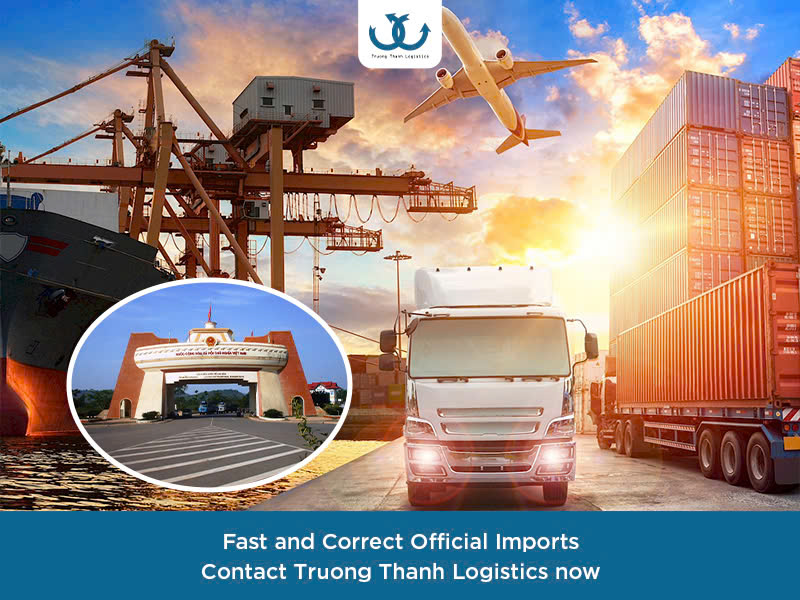
6. Truong Thanh Logistics – Your Trusted Official Import Partner
With over 13 years of experience in the import/export sector, Truong Thanh Logistics has become the trusted choice for thousands of clients thanks to its extensive experience and professional service. We have successfully handled thousands of official shipments across various sectors: from electronic devices and industrial machinery to raw materials, agricultural products, and fast-moving consumer goods.
What sets Truong Thanh Logistics apart is not just our speed and accuracy, but how we partner with our clients through every step of the import process:
+ Optimal Import Strategy Consulting: From the very beginning, our team of experts will analyze your needs, products, and market to propose the best import plan. This helps your business save costs, reduce risks, and ensure full compliance with legal regulations.
+ Negotiating with Carriers: We leverage our long-standing relationships with reputable shipping lines and airlines to negotiate competitive freight rates while ensuring stable shipping schedules that align with your business timeline.
+ Document Preparation and Verification: We meticulously prepare and review all documents related to your shipment to fully meet the requirements of customs and specialized regulatory agencies. This minimizes the chance of document errors that could lead to clearance delays.
+ Incident Handling and Quick Customs Clearance: In case of unexpected situations like missing documents, a request for specialized inspection, or transport issues, Truong Thanh Logistics always has flexible and swift solutions to get the shipment cleared in the shortest time possible.
With a combination of practical experience, a wide partner network, and a systematic workflow, Truong Thanh Logistics is committed to providing clients with a safe, efficient, and timely official import service.
For assistance with import and export information, international freight, sea transport or import entrustment, please contact Truong Thanh Logistics at the address:
Truong Thanh Logistics – Dedication, Prestige
Hotline: 0915 36 38 39
Headquarter: 5th Floor, Tower A, Song Da Building, Pham Hung, Tu Liem, Hanoi.
Email: sale@truongthanhjsc.com
info@truongthanhlogistics.com
Website: www.truongthanhlogistics.com
Hai Phong Branch
Address: R.A11, TTC Building, 630 Le Thanh Tong, Hai An, Hai Phong
Da Nang Branch
Address: 27 Nguyen Ba Lan, Ngu Hanh Son Ward, Da Nang.
HCMC Branch
Address: Room 41, 4th floor, Casanova building, 85 Nguyen Son street, Phu Thanh Ward, Ho Chi Minh City




